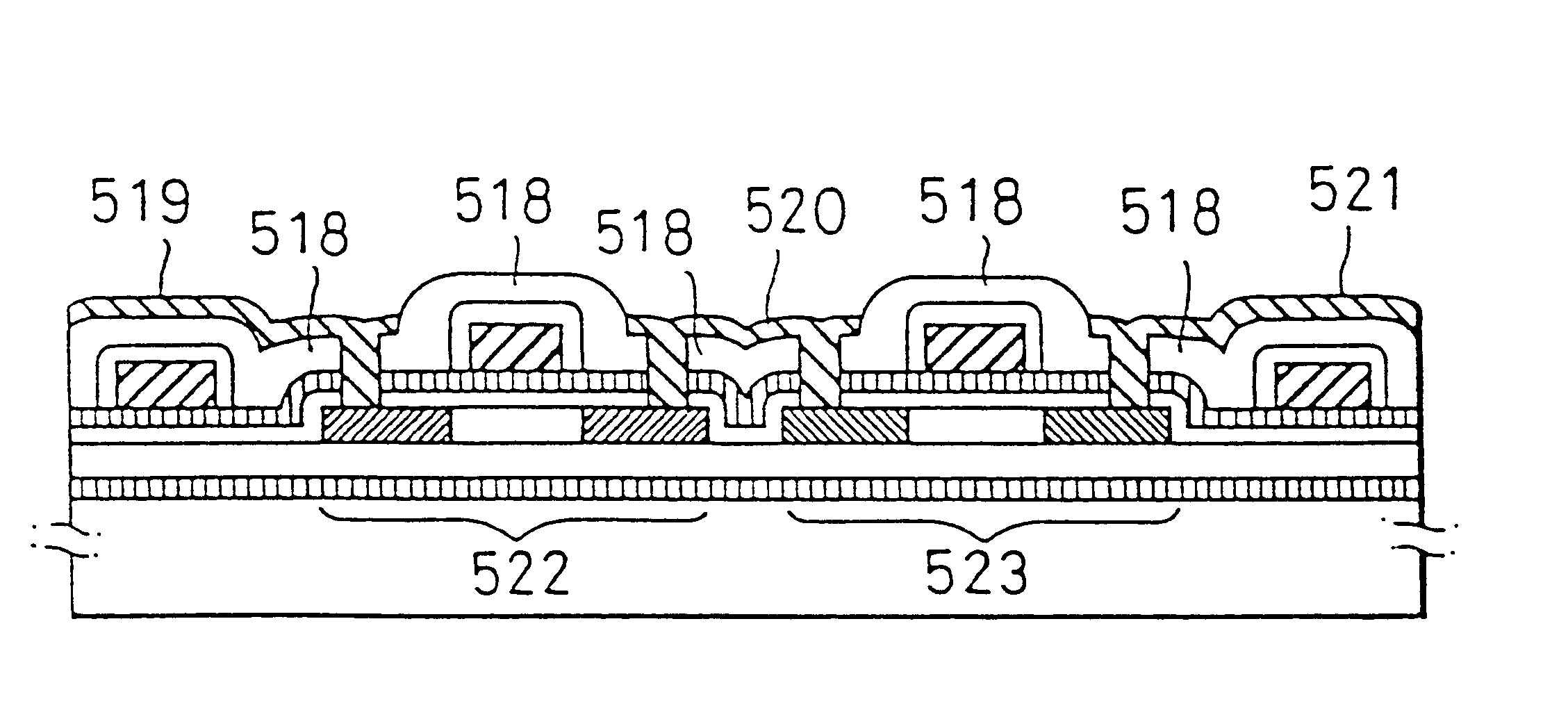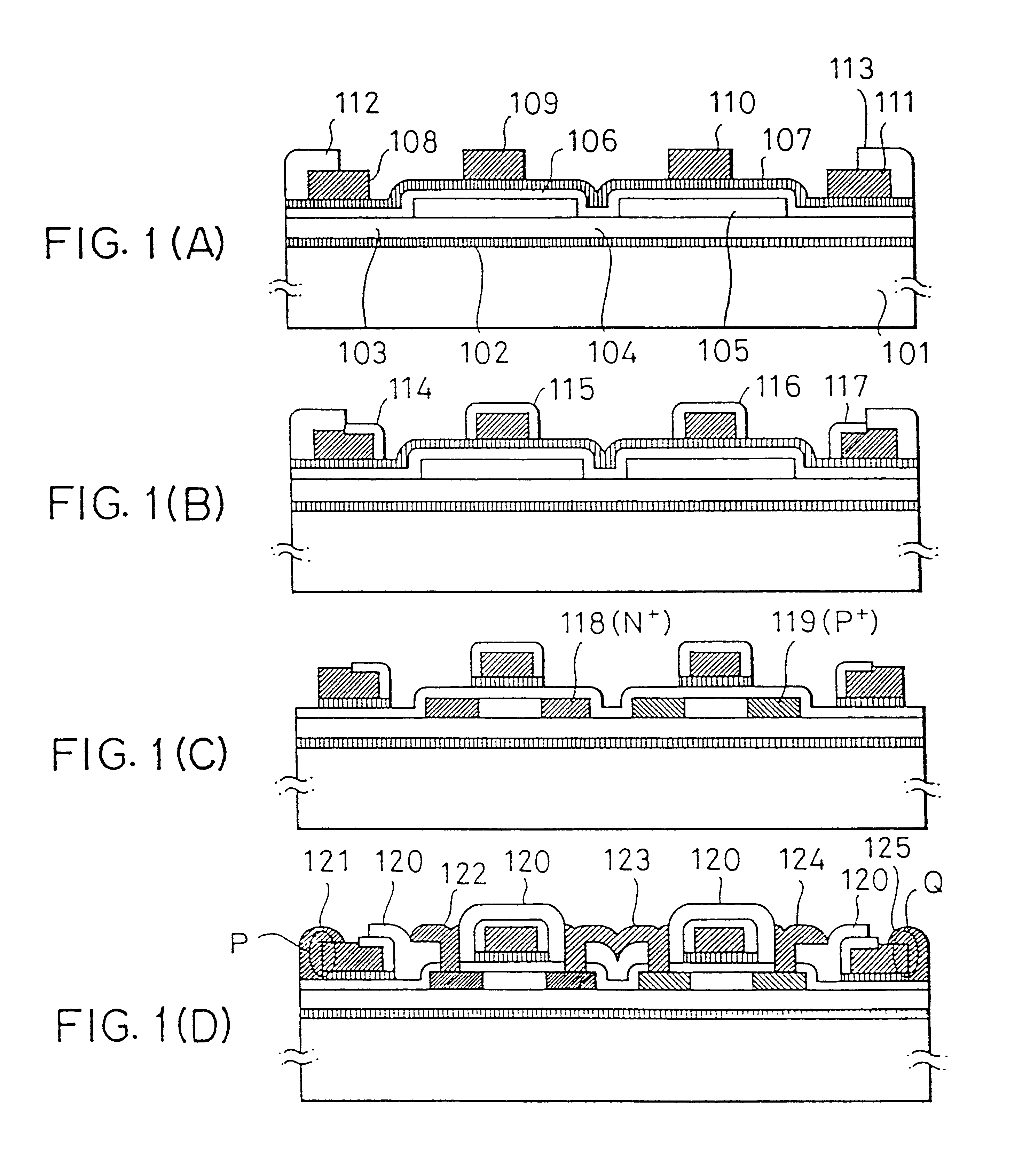Semiconductor device and method for forming the same
a semiconductor and gate technology, applied in the direction of semiconductor devices, electrical devices, transistors, etc., can solve the problems of low reproducibility, unobtainable excellent characteristics, and unobtainable excellent characteristics with high reproducibility, and achieve the effect of improving the flatness of the devi
- Summary
- Abstract
- Description
- Claims
- Application Information
AI Technical Summary
Benefits of technology
Problems solved by technology
Method used
Image
Examples
embodiment 1
FIG. 1 is cross-sectional views showing a manufacturing process of an embodiment. The detailed conditions of this embodiment are substantially identical to those of Japanese Patent Application No. 3-237100 which was filed by the inventor of this application, et.al, and the description thereof is not particularly made.
An N--O glass produced by Nippon Electric Glass Co., Ltd. was used as a substrate 101. This glass has high strain temperature, but contains a large amount of lithium and natrium. Therefore, in order to prevent invasion of these movable ions from the substrate, a silicon nitride film 102 was formed in thickness of 10 to 50 nm on the substrate by a plasma CVD method or a low pressure CVD method. Further, a silicon oxide film serving as a sealer was formed in thickness of 100 to 800 nm by a sputtering method. An amorphous silicon film was formed on the silicon oxide film in thickness of 20 to 100 nm by the plasma CVD method, and annealed at 600.degree. C. for 12 to 72 hour...
embodiment 2
FIG. 2 shows an embodiment in which this invention was applied to a TFT having two-layered channel which was invented by the inventor of this application, et.al., and described in applications filed on Feb. 25, 1992 entitled "THIN FILM INSULATING GATE TYPE OF SEMICONDUCTOR DEVICE AND A PRODUCING METHOD THEREFOR" (applicant: Semiconductor Energy Laboratory Co., ?Ltd, docketing numbers: P002042-01 to P002044-03).
That is, in FIG. 2, a reference numeral 201 represents an N-channel TFT, a reference numeral 202 represents a P-channel TFT, and first layers 208 and 210 at these channel regions were substantially formed of amorphous silicon. The thickness thereof was set to 20 to 200 nm.
Reference numerals 207 and 209 represent silicon in a substantially polycrystal or semi-amorphous state, and the thickness thereof was set to 20 to 200 nm. Reference numerals 204 and 206 represent gate insulating films formed of silicon oxide, and the thickness thereof was set to 50 to 300 nm. Reference numer...
embodiment 3
FIG. 3 shows a process for performing an anodic oxidation and then wiring using this invention. First, plural islandish semiconductor regions 302 were formed like the Embodiment 1, and a gate insulating film and a silicon nitride film of this invention (if occasion demands) were formed. Thereafter, aluminum gate electrode / wirings 303 were formed as a first conductor layer by patterning (FIG. 3(A)).
Subsequently, a wiring 304 for positive-electrode wiring was formed of chromium as a second conductor layer in contact with the gate electrode / wirings. The same condition for the chrome film as the Embodiment 1 was adopted (FIG. 3(B)).
Under the same condition as the Embodiment 1, the chrome wiring 304 was subjected to the anodic oxidation while kept to a positive potential, and an anodic oxide film 305 was formed on the surface of each gate electrode / wiring by making a current flow through the first conductor layer and the second conductor layer in an electrolyte. The oxide film 305 compri...
PUM
 Login to View More
Login to View More Abstract
Description
Claims
Application Information
 Login to View More
Login to View More - R&D
- Intellectual Property
- Life Sciences
- Materials
- Tech Scout
- Unparalleled Data Quality
- Higher Quality Content
- 60% Fewer Hallucinations
Browse by: Latest US Patents, China's latest patents, Technical Efficacy Thesaurus, Application Domain, Technology Topic, Popular Technical Reports.
© 2025 PatSnap. All rights reserved.Legal|Privacy policy|Modern Slavery Act Transparency Statement|Sitemap|About US| Contact US: help@patsnap.com



